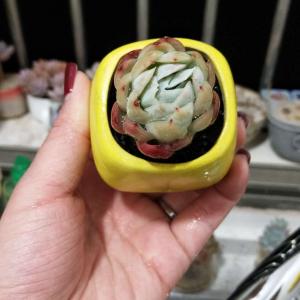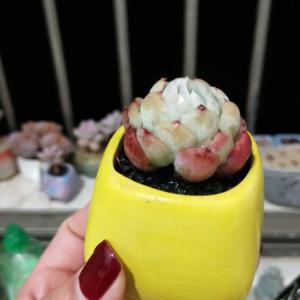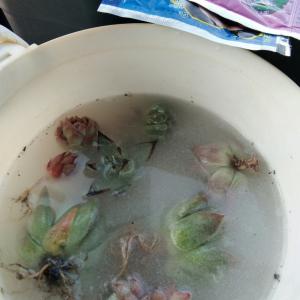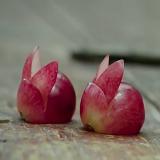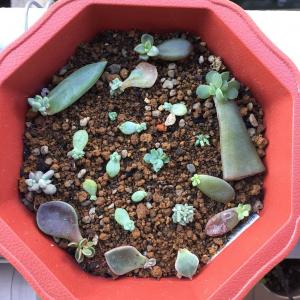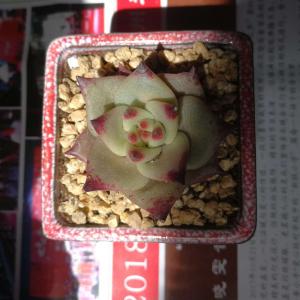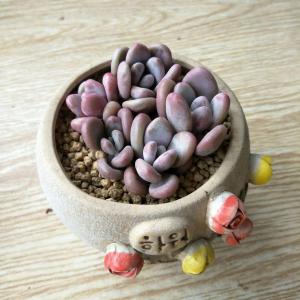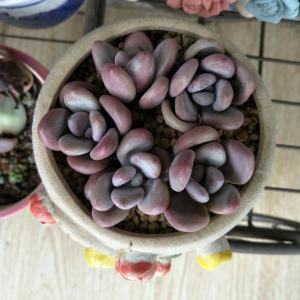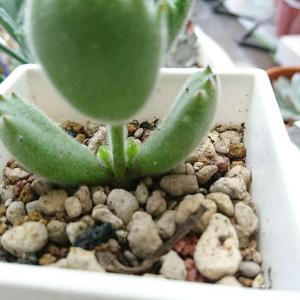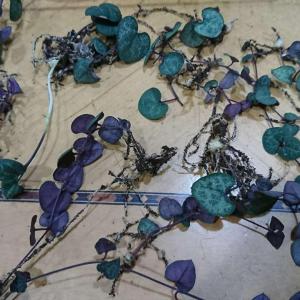文章
权问薇
2018年04月28日


一、春天用何种肥料
春天是它成长的旺盛期,对养料的需要分量比较多。可以在给它换盆的时候把已经炒熟了的葵花籽和木炭等混合在一起,给它当做底肥。在成长时期每10天左右给它加一次以氮为主的肥,要足够稀薄,可以帮助枝叶的成长。
二、夏天用何种肥料
夏日天气非常酷热,如果有25摄氏度以上的温度,君子兰是需要停止加肥的,如果肥料太多了,它的肉质的根会被烧坏。要是放在温度25度以下的区域,可以每十五天到二十天左右给它加一次非常淡的液肥,可以促进它的成长,减短它的休眠时期。
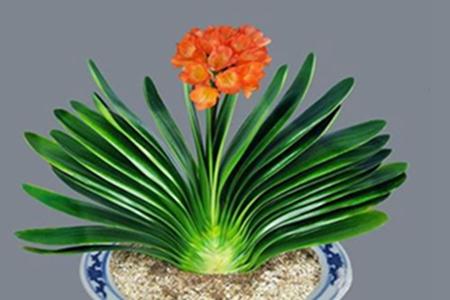
三、秋天用何种肥料
秋天也是它成长的旺盛期,需要的肥料比较多,除了在帮它换盆的时候放一些发酵了的饼渣之外,还应该每十五天给它放一次发酵了的鱼腥水。如果是比较小的苗,秋天要以氮肥为重,配上适度的磷钾元素,可以让它的叶更加的翠绿,成长更加的茁壮。成年的此种兰花秋天用磷肥配上一点点氮肥可以防止它的花箭裂开,长出更多的籽粒。

四、冬天用何种肥料
冬天应该要多给它加一些肥料,有些人认为冬天比较冷,即使给它上肥了它也进入了休眠期,不能吸收。但其实并不是这样的,它需要十五到二十五度的温度,冬天很多地域都能达到这个条件,这个时候正是它射箭的好时期,需要很多的养分。
当然,如果屋内的气温比十五度要低,可以适当的减少施肥的次数,等到低于十度了,就可以停止加肥了。只有做到合理的施肥,它的叶才能挺直翠绿,叶的光泽度才更好,叶片才能更加厚实,花朵才能更大更艳丽。还需要注意的是,如果肥太多了,叶很容易变黄,肉质的根很容易腐烂掉。

0
5
文章
权问薇
2018年04月27日


一、水养的方法
它一整年都是可以水养的,选取10㎝左右的枝条,最好是带有气生根的那种,把它插在瓶中,就可以很快的长出来新的根。在开始的时候要经常的给它换水,要是用自来水,千万记得提前晾晒。等到它的根长出来以后,就可以减慢换水的时间。
二、水养的好处
1、和用土养的方法来比,用水养它可以更加快速的长出根。
2、因为它不需要土,水又比土更加的干净,所以水养家中的环境会更加卫生一些。
3、要是用土养的方式,还需要给它浇水,但是水养就不需要这个环节了,在水养进入正轨之后,就不需要经常给它换水了,对于时间不是很充足的人来说特别方便。

三、水养的缺点
1、水养的方式虽然在后期成长的速度比土养要更快,但是前期的速度很慢,因为养分比较缺乏,成长的速度更加慢,就算前期加入了很多的养分,成长的速度也没有土养的快。
2、水养的方式因为成长条件的原因,看上去更加的嫩绿,颜色也更加的淡,看上去比较娇柔。
四、土养的办法
首先要给它选择排水效果特别好,十分疏松的土,然后选择木质化的枝,还可以给它加一些促进生根的药剂,可以让它更加快速的长出来根。在前期要把它放在阴凉的区域,不能让强烈的阳光直接照射,大概二十天左右就可以长出来根,根长出来十天之后就可以正常的养护了。

五、土养的优点
1、土养出来的植物,它的成长更加的强健,它可以从土中吸收养分,叶的颜色也会更加的翠绿。
2、土养的话,在初期根还没有长出来之前,成长的都比较慢,但是根长好以后,速度就会快上很多。
六、土养的缺点
土养需要主人更加的细心,对它采取更多的养护措施,需要及时的掌握花土的状况,水多了容易烂根,水少了叶容易蔫掉。

0
0
文章
Miss Chen
2018年04月22日

Description: This perennial herbaceous plant forms a semi-evergreen rosette of basal leaves up to 10" across. During the spring, this plant bolts, producing one or more erect to ascending stems with alternate leaves; these stems are 1½–3½' long. The stems are light green or yellowish green, terete, and somewhat brittle; they are usually glabrous below, while above they usually have hairs that are arranged in lines. The basal leaves and lower alternate leaves are up to 5" long and 2" across (excluding their petioles); they are cordate to ovate in shape and slightly to strongly toothed along their margins. The petioles of these leaves are winged and up to 5" long (usually shorter for the lower alternate leaves than basal leaves). As the alternate leaves ascend their stems, they become smaller in size, more narrow in shape (lanceolate-ovate to elliptic), and their winged petioles gradually become shorter.
Uppermost alternate leaves are often sessile or nearly so. The middle to uppermost alternate leaves have margins that are slightly toothed or toothless (entire). The teeth of all leaves, when they are present, are crenate to serrate. The upper leaf surface is dull medium green and sparsely covered with short stiff hairs, while the lower leaf surface is hairy primarily along the major veins. With age, some leaves may lose their hairs. The central stem and any upper secondary stems terminate in panicles of flowerheads about ½–1½' long and about one-half to one-third as much across. Together, these inflorescences often resemble a compound panicle of flowerheads. Individual flowerheads are about ½" (12 mm.) across, consisting of 8-12 pistillate ray florets that surround a dense head of 10-15 perfect disk florets. The petaloid rays are widely spreading, narrowly oblong in shape, and usually white (rarely lavender). The corollas of the disk florets are up to 5 mm. (nearly ¼") long and narrowly tubular with 5 uppers lobes; they are initially yellow, but later become pink or light purple.

The base of each flowerhead is surrounded by phyllaries (scale-like floral bracts) in several overlapping series. Individual phyllaries are greenish, linear-lanceolate in shape, and variable in size; they are appressed together or slightly spreading. The midsections of these phyllaries are dark green and linear in shape throughout; the tips of these phyllaries taper gradually into narrow stiff tips. The branches of each inflorescence and peduncles of the flowerheads are light green and sparsely hairy. Along the branches of each inflorescence, there are leafy bracts up to 1" long that are linear to narrowly elliptic in shape. The blooming period occurs from late summer to mid-autumn, lasting about 1 month for a colony of plants. Afterwards, the florets are replaced by achenes with small tufts of whitish hair; they are distributed by the wind. Individual achenes are about 2 mm. long, ellipsoid-oblongoid, slightly compressed, purplish brown or brown, and longitudinally ribbed. The root system is fibrous and short-rhizomatous; older plants often develop a small woody caudex. Sometimes, clonal offsets develop from the rhizomes.
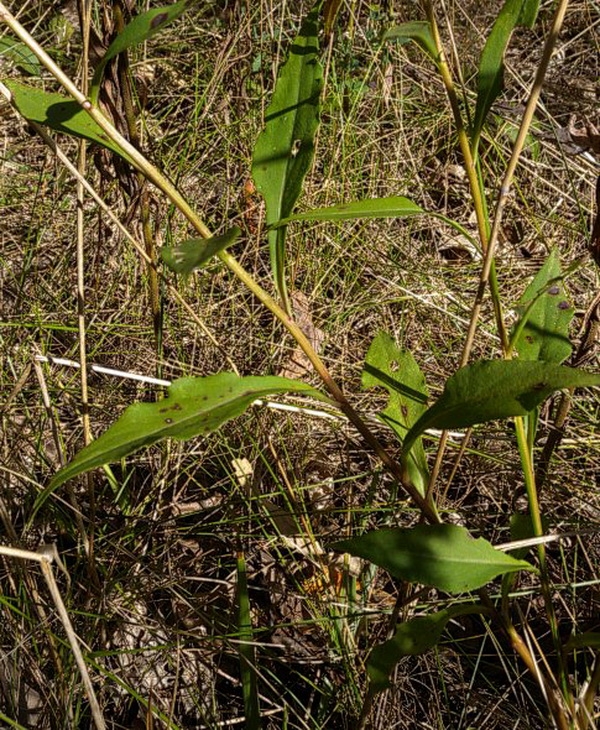
Cultivation: This plant prefers full or partial sunlight and mesic to dry conditions. A variety of soil types are tolerated, including those that contain loam, clay-loam, sandy-loam, or rocky material. This plant is not difficult to cultivate, although it should be watered during hot dry spells of the summer.
Range & Habitat: White Arrowleaf Aster is occasional throughout Illinois (see Distribution Map). This map is derived from information in Jones (1989). Habitats include upland savannas, sandy savannas, woodland edges, small meadows in upland areas, rocky glades, thickets, abandoned fields, roadsides, and areas near railroads. This plant is found in both high quality and disturbed habitats. It probably benefits from occasional fires in wooded areas, or other kinds of disturbance that thin-out the tree canopy.

Faunal Associations: The nectar and pollen of the flowerheads attract a wide variety of insects, including long-tongued bees, short-tongued bees, bee flies (Bombyliidae), wasps, butterflies, and skippers. Aster species (Symphyotrichum spp.) require cross-pollination from these insects in order to produce fertile seeds. The caterpillars of a butterfly, Phyciodes tharos (Pearl Crescent), feed on the leaves of asters, especially smooth-leaved species. Many moth species feed on the foliage and other parts of asters (see Moth Table), as do many other insects (see Insect Table), including leaf beetles, lace bugs, plant bugs, stink bugs, aphids, leafhoppers, larvae of leaf-mining flies, and larvae of fruit flies. Some vertebrate animals use aster species as a source of food. For example, the Wild Turkey and Ruffed Grouse feed on the seeds and young foliage. Deer, rabbits, groundhogs, and many domesticated farm animals also feed on the foliage, particularly when it is young.
Photographic Location: An upland meadow at Moraine View State Park in McLean County, Illinois.

Comments: White Arrowleaf Aster has a history of taxonomic instability. It has been regarded as a variety of Symphyotrichum cordifolium (Heart-leaved Aster) and Symphyotrichum sagittifolium (Arrow-leaved Aster) in the past. It is also similar to Symphyotrichum drummondii (Drummond's Aster). Some taxonomists consider Symphyotrichum sagittifolium to be a synonym for Symphyotrichum urophyllum, however A.G. Jones (1989) ultimately separated them taxonomically. White Arrowleaf Aster can be considered distinct from the preceding aster species in this group by the following characteristics: 1) the petaloid rays of this aster are usually white, rather than lavender, 2) the alternate leaves of this aster tend to be more narrow in shape, 3) the phyllaries of this aster have midsections that are dark green and linear in shape throughout their length, rather than narrowly diamond-shaped and dark green toward their tips, and 4) the phyllaries of this aster tend to have tips that are more tapered and stiff. White Arrowleaf Aster is also less hairy than Drummond's Aster. A scientific synonym of White Arrowleaf Aster is Aster urophyllus.
Uppermost alternate leaves are often sessile or nearly so. The middle to uppermost alternate leaves have margins that are slightly toothed or toothless (entire). The teeth of all leaves, when they are present, are crenate to serrate. The upper leaf surface is dull medium green and sparsely covered with short stiff hairs, while the lower leaf surface is hairy primarily along the major veins. With age, some leaves may lose their hairs. The central stem and any upper secondary stems terminate in panicles of flowerheads about ½–1½' long and about one-half to one-third as much across. Together, these inflorescences often resemble a compound panicle of flowerheads. Individual flowerheads are about ½" (12 mm.) across, consisting of 8-12 pistillate ray florets that surround a dense head of 10-15 perfect disk florets. The petaloid rays are widely spreading, narrowly oblong in shape, and usually white (rarely lavender). The corollas of the disk florets are up to 5 mm. (nearly ¼") long and narrowly tubular with 5 uppers lobes; they are initially yellow, but later become pink or light purple.

The base of each flowerhead is surrounded by phyllaries (scale-like floral bracts) in several overlapping series. Individual phyllaries are greenish, linear-lanceolate in shape, and variable in size; they are appressed together or slightly spreading. The midsections of these phyllaries are dark green and linear in shape throughout; the tips of these phyllaries taper gradually into narrow stiff tips. The branches of each inflorescence and peduncles of the flowerheads are light green and sparsely hairy. Along the branches of each inflorescence, there are leafy bracts up to 1" long that are linear to narrowly elliptic in shape. The blooming period occurs from late summer to mid-autumn, lasting about 1 month for a colony of plants. Afterwards, the florets are replaced by achenes with small tufts of whitish hair; they are distributed by the wind. Individual achenes are about 2 mm. long, ellipsoid-oblongoid, slightly compressed, purplish brown or brown, and longitudinally ribbed. The root system is fibrous and short-rhizomatous; older plants often develop a small woody caudex. Sometimes, clonal offsets develop from the rhizomes.

Cultivation: This plant prefers full or partial sunlight and mesic to dry conditions. A variety of soil types are tolerated, including those that contain loam, clay-loam, sandy-loam, or rocky material. This plant is not difficult to cultivate, although it should be watered during hot dry spells of the summer.
Range & Habitat: White Arrowleaf Aster is occasional throughout Illinois (see Distribution Map). This map is derived from information in Jones (1989). Habitats include upland savannas, sandy savannas, woodland edges, small meadows in upland areas, rocky glades, thickets, abandoned fields, roadsides, and areas near railroads. This plant is found in both high quality and disturbed habitats. It probably benefits from occasional fires in wooded areas, or other kinds of disturbance that thin-out the tree canopy.

Faunal Associations: The nectar and pollen of the flowerheads attract a wide variety of insects, including long-tongued bees, short-tongued bees, bee flies (Bombyliidae), wasps, butterflies, and skippers. Aster species (Symphyotrichum spp.) require cross-pollination from these insects in order to produce fertile seeds. The caterpillars of a butterfly, Phyciodes tharos (Pearl Crescent), feed on the leaves of asters, especially smooth-leaved species. Many moth species feed on the foliage and other parts of asters (see Moth Table), as do many other insects (see Insect Table), including leaf beetles, lace bugs, plant bugs, stink bugs, aphids, leafhoppers, larvae of leaf-mining flies, and larvae of fruit flies. Some vertebrate animals use aster species as a source of food. For example, the Wild Turkey and Ruffed Grouse feed on the seeds and young foliage. Deer, rabbits, groundhogs, and many domesticated farm animals also feed on the foliage, particularly when it is young.
Photographic Location: An upland meadow at Moraine View State Park in McLean County, Illinois.

Comments: White Arrowleaf Aster has a history of taxonomic instability. It has been regarded as a variety of Symphyotrichum cordifolium (Heart-leaved Aster) and Symphyotrichum sagittifolium (Arrow-leaved Aster) in the past. It is also similar to Symphyotrichum drummondii (Drummond's Aster). Some taxonomists consider Symphyotrichum sagittifolium to be a synonym for Symphyotrichum urophyllum, however A.G. Jones (1989) ultimately separated them taxonomically. White Arrowleaf Aster can be considered distinct from the preceding aster species in this group by the following characteristics: 1) the petaloid rays of this aster are usually white, rather than lavender, 2) the alternate leaves of this aster tend to be more narrow in shape, 3) the phyllaries of this aster have midsections that are dark green and linear in shape throughout their length, rather than narrowly diamond-shaped and dark green toward their tips, and 4) the phyllaries of this aster tend to have tips that are more tapered and stiff. White Arrowleaf Aster is also less hairy than Drummond's Aster. A scientific synonym of White Arrowleaf Aster is Aster urophyllus.
0
0
求助
风筝290914
2018年04月12日
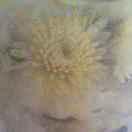
玛格丽特,花市买回来,换盆10天左右,土是大袋装的营养土,每天早上浇水,为啥颜色越来越淡了呢,蓝圈是原来的颜色,开始慢慢淡了,新开的都有点白色,什么原因呢?😭该怎么救?

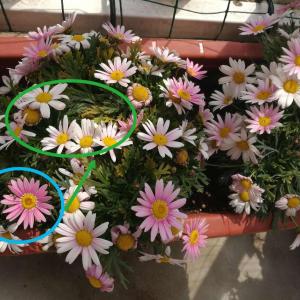


0
0
成长记
ICYC
2018年04月06日

冒頭很久都沒成長的月光兔小芽,出門三天後回來卻有了明顯成長
2017/10/2
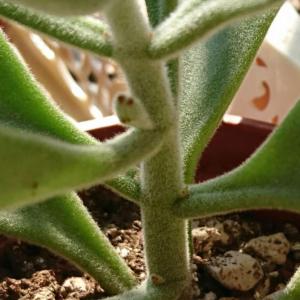
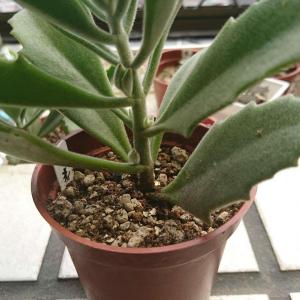
2017/10/2


0
0
ICYC:@莫助 可是我真的好喜歡他們的腋毛www
莫助:太常關注他的腋毛他會害羞😂不理他就長出來了



